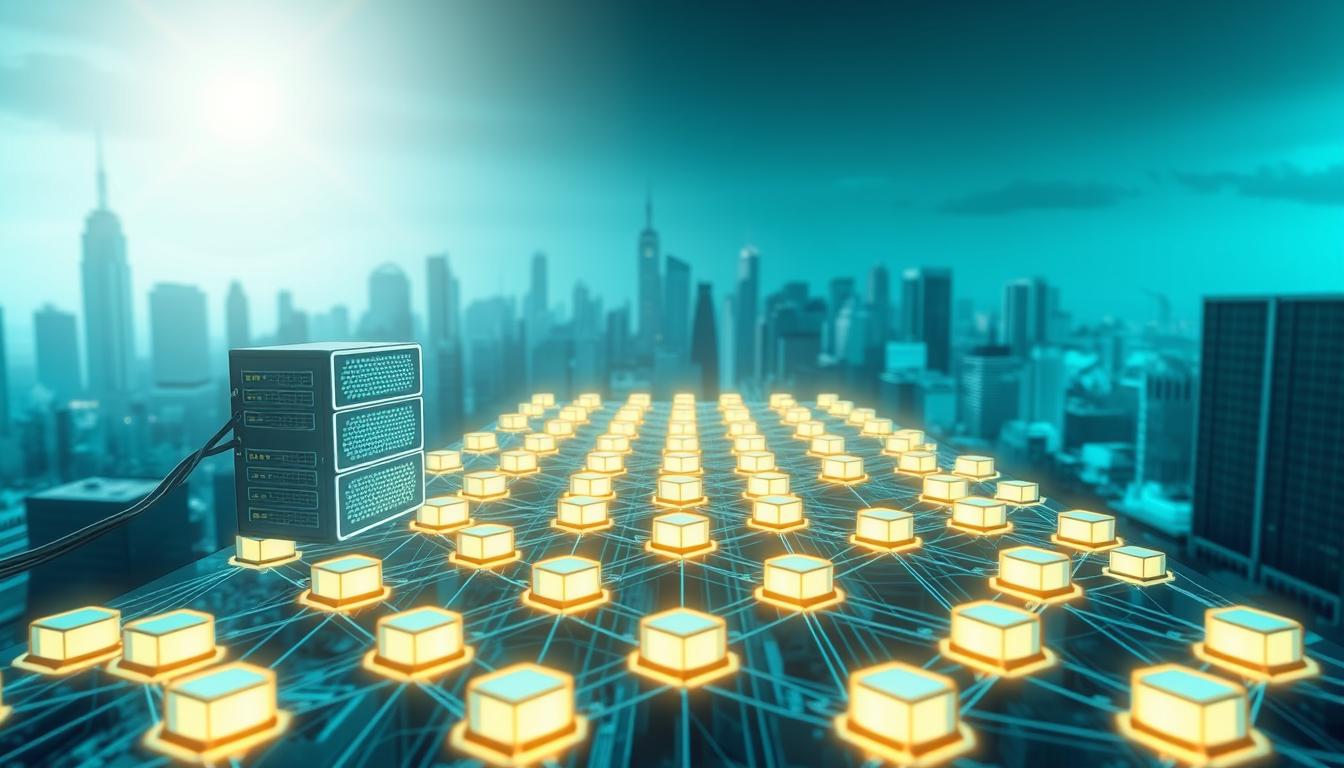Now Reading: NFT Smart Contract ERC Standard: A Comprehensive Guide
- 01
NFT Smart Contract ERC Standard: A Comprehensive Guide
NFT Smart Contract ERC Standard: A Comprehensive Guide
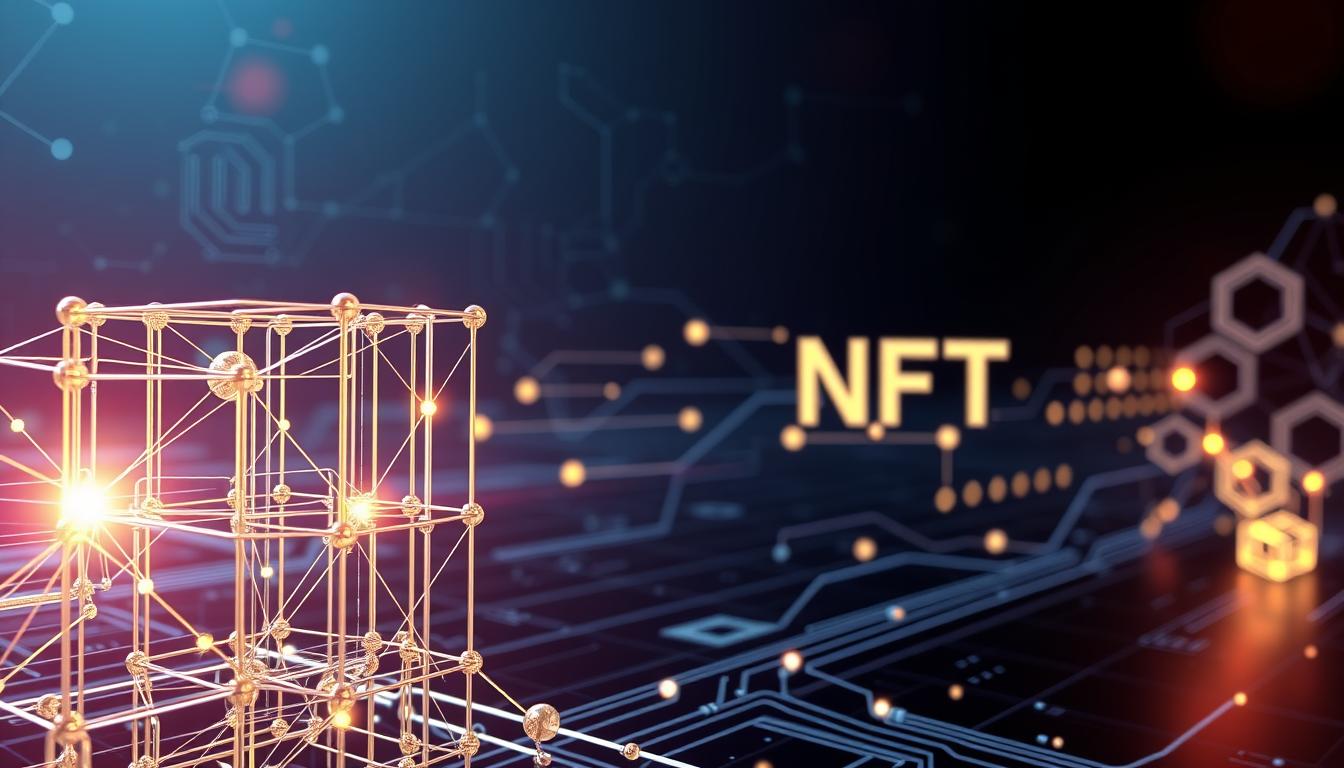
The digital collectibles space has witnessed an explosion in recent years. Trading volumes for unique digital assets skyrocketed from $82 million in 2020 to a staggering $17.6 billion in 2021. This represents an unprecedented surge in interest and value.
This growth highlights the need to understand the technology behind these assets. At the core of this digital revolution lies a specific set of rules on the blockchain. These protocols ensure each token is unique and can be properly managed.
This guide explores the foundational frameworks that power these tokens. We will delve into how these technical specifications, like those detailed in our resource on ERC standards, enable creation and secure ownership. Understanding these building blocks is crucial for anyone involved in the ecosystem.
Key Takeaways
- The market for unique digital tokens experienced monumental growth between 2020 and 2021.
- Technical protocols on the blockchain are essential for defining and managing these assets.
- Ethereum remains the dominant platform, utilising specific frameworks for development.
- These foundational rules ensure each digital item is distinct and tradable.
- Grasping these concepts is vital for creators, collectors, and investors.
Introduction to NFT Smart Contract ERC Standard
Digital property rights are being redefined through cryptographic verification systems. These systems enable unique digital items to have provable ownership and transferability. The technology behind this revolution involves specific protocols that ensure each asset remains distinct.
Defining NFTs and Smart Contracts
Non-fungible tokens represent unique digital or physical assets. They can include artwork, game items, and real estate. Each token possesses distinctive characteristics that prevent equal exchange.
Smart contracts are self-executing code written into blockchain networks. They govern crucial actions like verifying ownership and managing transferability. These contracts operate without intermediary involvement.
| Asset Type | Fungibility | Examples | Ownership Verification |
|---|---|---|---|
| Digital Art | Non-fungible | Unique artwork pieces | Blockchain record |
| Collectibles | Non-fungible | Rare digital items | Smart contract |
| Game Items | Non-fungible | Weapons, characters | Token standards |
| Access Keys | Non-fungible | Event tickets, memberships | Cryptographic proof |
The Importance of Token Standards
Token standards provide application-level specifications for how crypto tokens function. They enable smart contracts to fulfil essential roles within blockchain ecosystems. These specifications ensure consistent functionality across diverse platforms.
Standardisation guides developers in creating and deploying new tokens. It enables interactions between different applications and systems. This interoperability is crucial for the broader adoption of digital assets.
Understanding Token Standards on the Ethereum Blockchain
To ensure consistency across its vast ecosystem, Ethereum utilises a system of technical specifications known as Ethereum Request for Comments. These documents act as a universal rulebook, providing a common language for developers.
This framework is vital for creating a cohesive environment where different applications can interact without friction. It establishes a foundation of trust and predictability for users and builders alike.
What Are ERC Rules and Their Significance
Ethereum Request for Comments represents a collection of technical protocols. They define the specific methods and behaviours that every Ethereum-based digital asset must follow.
Programmers author these documents to set mandatory rules. This ensures all tokens operate uniformly, guaranteeing compatibility across wallets, exchanges, and decentralised applications.
The primary significance lies in fostering interoperability. By adhering to these protocols, developers can be confident their creations will function seamlessly within the broader Ethereum ecosystem.
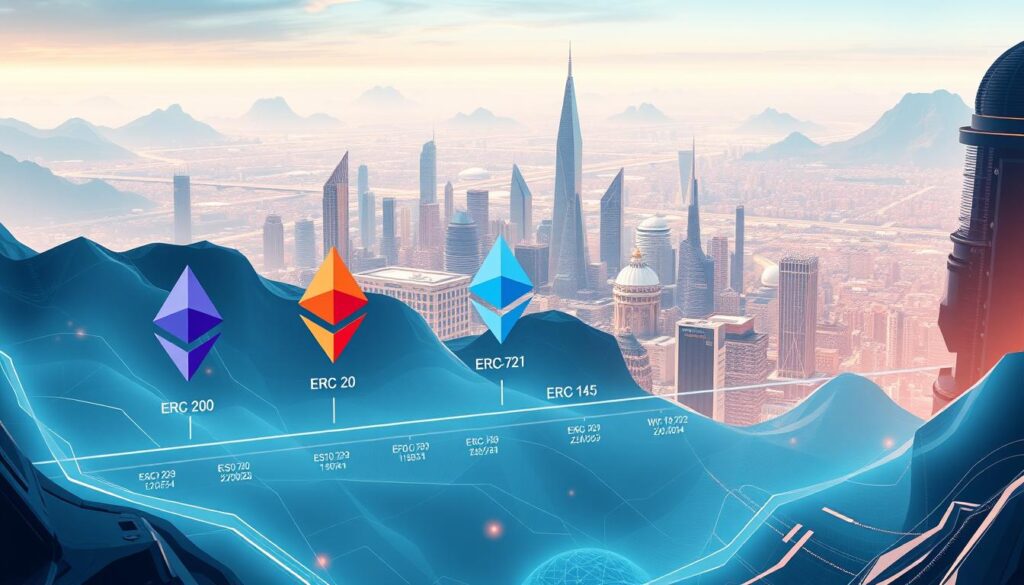
The Evolution of ERC Protocols
The history of these specifications shows a responsive and evolving system. The journey began in 2015 with the introduction of a protocol for fungible tokens, similar to traditional currencies.
A significant milestone occurred in 2017 with the approval of a new protocol designed specifically for unique digital assets. This demonstrated the platform’s ability to adapt to emerging use cases.
The process for creating a new protocol is open yet rigorous. Anyone can submit a proposal, but it must undergo extensive community review and revision before final acceptance. This ensures high quality and broad consensus.
Detailed Comparison: ERC-721 versus ERC-1155
While both specifications enable unique digital ownership, their operational methodologies differ significantly. The earlier framework emerged in 2017 through the work of William Entriken and colleagues. This innovation established foundational rules for non-interchangeable digital items.
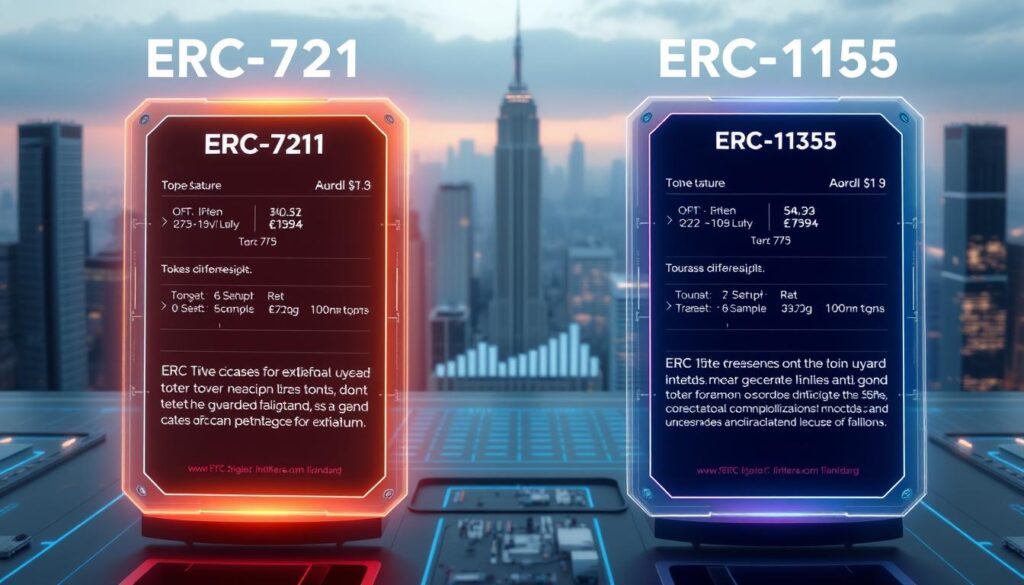
Key Features of ERC-721 Tokens
The original protocol requires individual agreements for each asset. Every item receives a unique identifier within its own dedicated code structure. This approach ensures absolute uniqueness but creates operational inefficiencies.
CryptoKitties demonstrated this system’s capabilities beautifully. Each digital cat existed as a completely distinct entity. However, processing single assets per operation led to substantial network costs.
Advantages of ERC-1155 Tokens
The multi-token approach revolutionised efficiency by 2018. A single agreement can manage various asset types simultaneously. This includes interchangeable, unique, and hybrid items that change states.
Batch processing represents the most significant improvement. Multiple items transfer in one operation, reducing network congestion dramatically. Costs can decrease by up to 90% compared to older methods.
| Feature | ERC-721 | ERC-1155 | Key Difference |
|---|---|---|---|
| Contract Structure | One per token | Single multi-token | Storage efficiency |
| Transfer Method | Individual only | Batch capable | Network impact |
| Token Types | Non-fungible only | Multiple varieties | Flexibility |
| Cost Efficiency | Higher fees | Up to 90% savings | Economic viability |
| Security Features | Basic validation | Enhanced protections | Risk management |
The newer framework also introduced advanced safety mechanisms. Failed operations automatically return items to their original owners. Multi-language metadata support further enhances global accessibility.
Use Cases and Real-World Applications
The practical implementation of these unique digital assets spans from fantasy sports to virtual property deeds. These tokens have moved beyond theoretical concepts into functioning ecosystems that serve diverse purposes.
Digital Art, Collectibles and Gaming
Digital artwork represents the most recognised application for these unique tokens. Platforms like CryptoKitties demonstrated how digital collectibles could create entirely new gaming experiences. Players could breed, own, and trade unique digital cats represented by individual tokens.
The Sandbox metaverse shows advanced gaming applications using multi-token standards. Here, ASSET tokens represent in-game items like weapons and wearables. Players can buy and sell these items using the platform’s native currency.

Sports enthusiasts enjoy platforms like Sorare, which combines fantasy football with limited edition player cards. These digital collectibles function as tradeable assets within the sports entertainment sector.
Virtual Real Estate and Beyond
Virtual real estate platforms facilitate decentralised trading of land within metaverse environments. These applications represent some of the most ambitious use cases for digital property ownership.
Utility-focused applications include Ethereum Name Service, which provides human-readable blockchain addresses. POAP distributes free tokens as proof of attendance for events. These practical applications demonstrate the technology’s versatility beyond mere collectibles.
The Bored Ape Yacht Club collection shows how tokens can function as membership credentials. Holders receive increasing perks through community efforts, creating value beyond the initial artwork.
| Marketplace Type | Primary Focus | Notable Examples | Key Feature |
|---|---|---|---|
| Mass Marketplaces | Diverse collections across industries | OpenSea, Rarible | Broad assortment |
| Gaming Platforms | VR and interactive collectibles | The Sandbox, Decentraland | Immersive experiences |
| Sports Platforms | Highlights and trading cards | Sorare, NBA Top Shot | Sports memorabilia |
| Curated Art Markets | Unique single-edition pieces | Foundation, SuperRare | Artist exclusivity |
These diverse applications demonstrate the technology’s adaptability across multiple sectors. From gaming items to virtual real estate, the practical use cases continue to expand.
Technical Aspects: Single Transaction and Batch Transfers
Transaction speed and resource consumption vary dramatically between different digital token implementations. The architectural differences significantly impact user experience and operational costs.
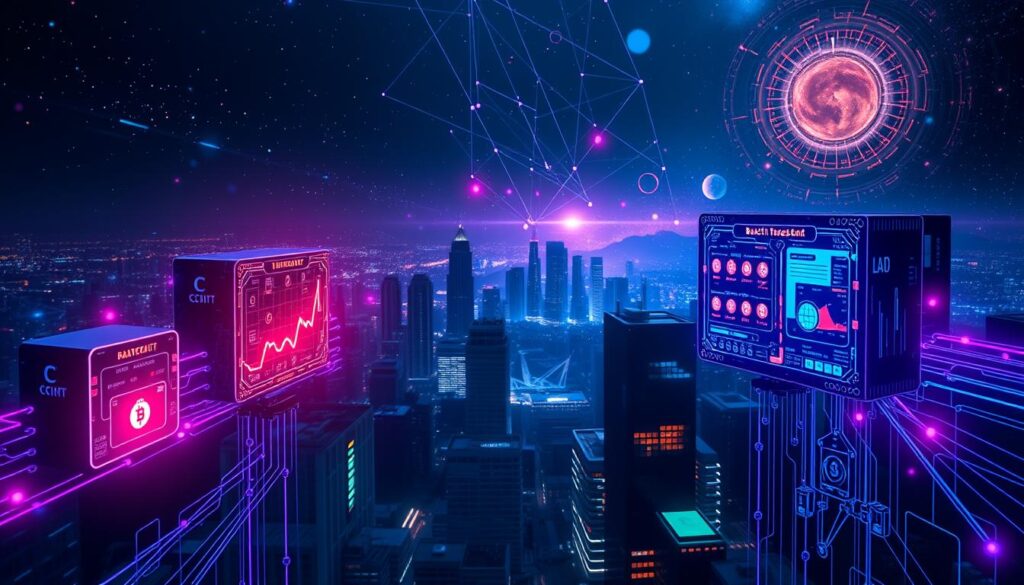
Processing methods reveal fundamental distinctions in how digital items move across networks. These technical choices affect everything from gas fees to security protocols.
Efficiency and Gas Fee Considerations
Individual item processing requires separate operations for each transfer. This approach consumes more blockchain resources and increases transaction costs significantly.
Batch operations revolutionise efficiency by handling multiple items simultaneously. Optimised implementations can process hundreds of tokens per second. This reduces network congestion and lowers fees substantially.
Storage requirements also differ considerably. Managing multiple items within single agreements saves considerable space compared to separate deployments.
Metadata Flexibility and Transaction Security
Metadata handling demonstrates another critical distinction. Static incorporation within agreements limits dynamic content updates. Flexible URI systems enable countless codes and multilingual support.
Security features include automatic validity verification patterns. Invalid transactions safely return items to their original owners. This prevents permanent loss from user errors.
Comprehensive logging tracks entire lifecycles from creation to retirement. Advanced functions enable multi-asset queries and controlled management options.
Regulation, Adoption and Future Trends
Mainstream adoption of unique digital assets has accelerated dramatically, prompting both innovation and regulatory scrutiny. The market experienced an unprecedented 21,000% surge from 2020 to 2021, reaching $17.6 billion in trading volume.
TechNavio projects the sector will grow by $147.24 billion between 2021 and 2026. This explosive growth reflects increasing public awareness and new opportunities for creators.
Market Growth and Developer Innovations
Artists and creators now have revolutionary ways to showcase their collections and maintain relationships with collectors. Programmable royalty systems within agreements ensure ongoing compensation.
Despite competition from networks like Cosmos and Polkadot, Ethereum maintains dominance. Its established ecosystem and mature infrastructure support continuous upgrades to technical specifications.
Migration to newer protocols offers expanded functionality. Organisations can achieve greater efficiency and significant cost savings. Enhanced security features protect digital assets and ownership rights.
Future applications extend beyond current use cases. Emerging trends include intellectual property management and real-world asset representation. Regulatory frameworks worldwide are evolving to address taxation and consumer protection.
Developer innovations focus on interoperability and sustainability. Layer-2 solutions reduce transaction costs while proof-of-stake mechanisms improve environmental impact. These advancements will shape institutional adoption.
Conclusion
Choosing the right technical framework is paramount for success in the evolving world of unique digital items. Understanding these protocols proves essential for creators, collectors, and developers navigating the digital asset ecosystem.
The distinction between pioneering specifications remains crucial. The ERC-721 token standard launched the revolution with individually managed tokens, while newer approaches enable batch processing and enhanced efficiency. Each framework serves distinct purposes based on project requirements.
These living specifications continue adapting to technological advances and market demands. As the space matures, staying informed about developments ensures optimal choices for representing digital physical assets. The evolution toward greater flexibility and cost-effectiveness benefits the entire ecosystem.
FAQ
What is the primary difference between an ERC-721 and an ERC-1155 token?
The main distinction lies in how they handle uniqueness. An ERC-721 token standard is designed for non-fungible tokens, where each asset is entirely unique, like a specific piece of digital art on OpenSea. In contrast, the ERC-1155 protocol supports creation of both unique items and fungible tokens within a single smart contract, offering greater flexibility for applications like in-game items.
Why are token standards like ERC-721 and ERC-1155 important for the ecosystem?
These standards provide a common set of rules that ensure compatibility across different platforms, such as wallets and marketplaces like Rarible. This interoperability is crucial for a healthy digital economy, as it allows assets to be traded and used in various applications without technical issues, fostering wider adoption and innovation.
Can ERC-1155 be used for physical assets, such as real estate?
While primarily for digital goods, the standard’s ability to represent ownership rights makes it a candidate for tokenising physical assets. This could involve representing shares in a property or certificates of authenticity for collectibles. However, linking the digital token to the physical world requires robust legal frameworks and verification processes.
How do batch transfers in ERC-1155 improve efficiency?
Batch transfers allow multiple tokens to be sent in a single transaction on the Ethereum blockchain. This significantly reduces gas fees compared to initiating separate transactions for each asset. This feature is particularly beneficial for gaming applications where players might need to transfer several items at once.
What are the key considerations for developers choosing between these standards?
Developers should consider the nature of the assets. If every item must be completely unique, such as for a collection of digital art, ERC-721 is the appropriate choice. For projects involving multiple types of tokens—like a game with currencies and unique items—ERC-1155 offers a more gas-efficient and streamlined solution within a single smart contract.



